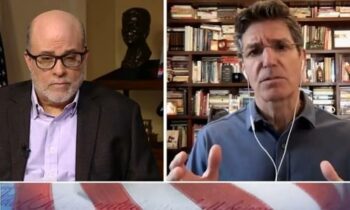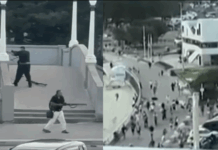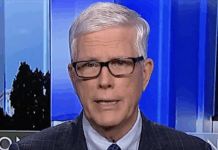By Mark Ellis –

Many hold out hope for a vaccine to bring our present COVID-19 pandemic to an end. But development of a vaccine is not a certainty and could take months or years to develop, while millions suffer job losses and economic devastation. The second-best hope to escape our nightmare in a timely way is herd immunity.
A month ago, Dr. David L. Katz, wrote a significant piece in the New York Times, “Is our fight against Coronavirus worse than the disease?” He advocated a pivot from our current health policy to a “surgical approach” in fighting the disease. On April 19th, he appeared on the Mark Levin program, “Life, Liberty, & Levin,” with an updated view.
Dr. Katz is the founding director of Yale University’s Yale-Griffin Prevention Research Center.
He observed that recent setbacks in Singapore and South Korea demonstrate that shutting people away only forestalls the inevitable spread of the virus.
“One of the things we’ve heard in the news is that Singapore did so well but now they are starting to have a resurgence of cases or South Korea the same. That’s what will happen if you lock everybody away from everybody else and wait for things to get better and then let everybody out in the world. The virus is still out there. We don’t have antibodies. We’ll just get it later,” he told Levin.
“If all you do is flatten the curve, you don’t prevent deaths or disease, you just change the dates. We don’t want to do that.”
He says there are only two options to prevent that course. One is a vaccine and the other is herd immunity.
“Herd immunity is when people who are prone to the milder forms of this infection get it, get over it, get antibodies and are immune…if I have antibodies, I can’t get it and I can’t give it to you, so it doesn’t matter if you’re vulnerable. If we shake hands you won’t get it from me.”
When enough people have antibodies, the virus can’t get through the population. “It finds it harder to get through to a host where it can survive and it dies out, that’s herd immunity,” Dr. Katz told Levin.
“This looks to me to be the best way where we can get to a place where grandparents can once again hug their grandchildren,” he noted. “I have 80-year-old parents and my mother doesn’t want to get coronavirus and die. She also doesn’t want to die of something else before ever being able to hug her grandchildren again because she’s still waiting for a vaccine.
“Herd immunity give us a much more proximal way to get back to life in the world as we knew it.”
In Dr. Katz’s piece in The Times, he wrote: “As we battle the coronavirus pandemic, and heads of state declare that we are ‘at war’ with this contagion, the same dichotomy applies. This can be open war, with all the fallout that portends, or it could be something more surgical. The United States and much of the world so far have gone in for the former. I write now with a sense of urgency to make sure we consider the surgical approach, while there is still time.”
His surgical approach involves preferentially protecting people with pre-existing conditions and those over age 60 from exposure, a position first advocated by this writer in a piece published March 24th.
“I’m trained in epidemiology and I understand the potential for a virus like this to hurt people and kill people. I’m also trained in social determinants of health and how food insecurity and unemployment and social upheaval can translate into health devastation,” he said.
One striking example is the 8,000% increase in calls coming into one of the three primary suicide prevention hotlines in the U.S. during the month of March due to COVID-19.
As Dr. Katz reviewed the data coming from China and South Korea, he was struck by the massive risk differentials, people at very high risk of severe complications from Coronavirus and potential death. At the same time there was an even greater segment of the population at massively lower risk.
“If that was true, a massive one-size-fits-all interdiction strategy – let’s keep everybody away from everybody and shut everything down – had the potential to hurt more people than it helped,” he concluded.
Sadly, this is the course recommended by President Trump’s closest medical advisors, which has led to job losses comparable to The Great Depression.
Tragically, as of April 20th, more than 42,000 have died due to COVID-19. But “there have been a thousand times as many people are being affected by economic upheaval and societal disruption,” Dr. Katz observed.
The original models projected millions potentially dying in the U.S. from the infection, then the numbers were lowered to hundreds of thousands, and finally the more recent estimates have been lowered to 60,000 dying – less than the seasonal flu in 2018.
The lowered estimate, however, is not due to the lock-down mitigation strategy, but because their models and data were wrong. “They never had enough data,” according to Dr. Katz.
While some say we must test everyone before the economy re-opens, Dr. Katz says a more modest and less time-consuming testing program can effectively guide good policy.
“We need to do what is called representative random sampling, a small population representative of a state or the U.S. That can take 72 hours…we do this data collection for three days and then pivot to vertical interdiction. We can phase people back to life as we knew it based on risk,” he told Levin.
It is already know that older people are at greater risk, along with those with heart disease and diabetes. “We can already say there are low-risk populations that can start to go back to the world. The CDC does these representative random samples all the time, so get that data and use it to inform public policy so we know who is at lower risk here and who can go back to the world.
“We have to go back to the world if we want the world back before there is a vaccine, which is 18 months to two years. We don’t know, it is just hope that we can have a vaccine – it could be much longer.”
The shocking conclusion is that those at low risk need to get the virus so that the vulnerable will be protected! “The only other way to get back to the world as we knew it is to develop herd immunity, which is to admit that those of us at low risk for severe infection actually need to get this thing and get over it and make antibodies.”
All of this should be data informed, according to Dr. Katz. Pivoting to a risk-based interdiction and phasing people back to work could start right away, as the work of gathering data proceeds to further refine the approach – always with the goal of minimizing harm.
“The virus can hurt people, unemployment can hurt people, social upheaval can hurt people. We want to minimize all of those harms across the expanse of public health and the economy.
“We already have a lot of information about these risk differentials and targeting protections to those who most need it and phasing people back in the world.
“This looks to me, as it did a month ago when I wrote in the New York Times, as the best way to minimize the total harms of this.”




Hi Mark
Seems the numbers in this article are very flawed. We have 45,000 death from covid in the US already. If that number is only going to get to 60,000-80,000 death with 2.000-3,000 people dying everyday we will be at over 60,000 in two weeks. This is not stopping or slowing down. Some points may be made for herd Immunity but your numbers are way off. To say only 80,000 death from herd immunity is wrong and sending the wrong message. Please look at these figures. We are talking about a lot more people dying from herd immunity. That’s the process. Let the strong survive. It is effecting every age group. You will have people bringing it into places where others are vulnerable. Those that have to work will get sick and be at greater risk. Wealthy people that can afford to stay home will. Things to think about. Thanks Bob
Comments are closed.